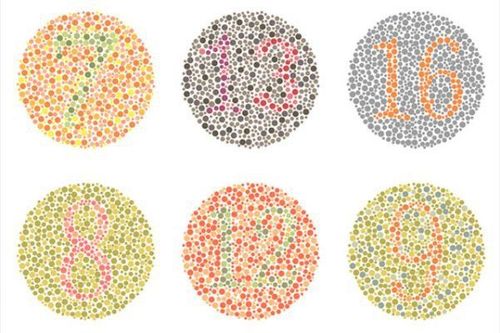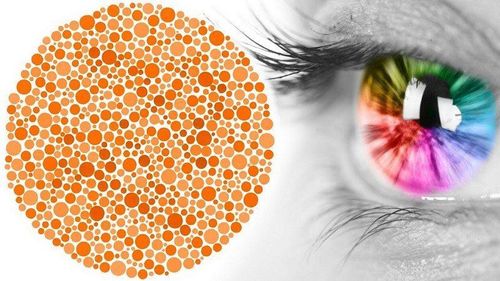This is an automatically translated article.
The article was written by Specialist Doctor II Nguyen Thai Hung, Eye Doctor - Department of Medical Examination & Internal Medicine - Vinmec Da Nang International General HospitalColor blindness, also known as dyschromia or dyschromia, is an eye disease in which people can see things clearly but cannot distinguish certain colors. The disease does not affect the patient's ability to live, so infected people can still live and reproduce normally, so the disease gene is at risk of spreading in the community.
1. What is color blindness?
Color blindness, also known as chromosomal disorder, is a condition in which the eye is unable to distinguish the colors of things such as red, green, blue or when mixed between these colors.
People with color blindness can still see things and phenomena clearly, but their ability to perceive colors is reduced, rare cases of multi-color blindness or being unable to see any color. Color blindness is not likely to affect the survival or reproduction of people with color blindness, but the gene can be passed on to the next generation.
Color analysis is mainly performed by cones, which are concentrated in the central fossa of the retina. When these cones lose the ability to distinguish colors, it causes color blindness or color blindness.
2. Why color blindness?
There are many risk factors as well as causes for color blindness. The most commonly thought to cause color blindness:
Genetic disorders: congenital color blindness is a common condition with a higher incidence in males than females. They will lose the ability to see blue (common) or yellow (rare). Depending on the severity, color blindness is divided into mild, severe or moderate forms. The severity is usually unchanged and there is a risk of affecting both eyes. Undesirable effects of some drugs: some drugs have the ability to affect the ability to distinguish colors, causing color blindness such as cardiovascular drugs, blood pressure, erectile dysfunction, infections, disorders. Neurological disorders ... Complications when suffering from some other chronic diseases: diabetes, cardiovascular disease, glaucoma, Alzheimer's, Parkinson's, leukemia and sickle cell anemia can affect your vision. you cause color blindness. These cases are usually color blind in one eye, sometimes both eyes. After treatment, color blindness can be relieved and restored. Aging: Vision and color discrimination also decrease with age, causing color blindness in the elderly.

Có nhiều nguyên nhân khác nhau gây bệnh mù màu
3. Symptoms of color blindness
There is a problem with vision but the patient himself does not detect it. Certain colors cannot be distinguished, others are still distinguishable. Mild degree, people with color blindness often have difficulty distinguishing colors such as green - red, blue - yellow. The severity does not distinguish the colors from each other. Rarely, only white, black, and blue can be seen.
4. How to overcome color blindness
Currently, there is no proven remedy that can completely cure color blindness. However, there are a number of measures that play a role in overcoming the consequences of color blindness such as:
Children with color blindness need to be informed to the teacher in charge of the difficulties that the child encounters in distinguishing between colors. color difference, to get support from teachers and schools. Color blindness due to drug use or complications from an underlying medical condition may improve with discontinuation of the drug or treatment of the underlying cause. Color filter: this is a new type of glass developed by scientists with the feature of increasing the contrast between colors that the patient cannot distinguish. However, it should be noted that color filters only have a role in the treatment of symptoms, not the cause of color blindness. It is important that people with color blindness, especially people with color blindness, learn to live with this lack of color discrimination. Remembering the order of traffic lights can help people with color blindness comply with the law when participating in traffic when they cannot distinguish the colors of the lights. Smartphone apps can be useful to help people with color blindness recognize colors.

Người bệnh nên đến bệnh viện để được khám chuyên khoa mắt
5. How to prevent color blindness
Comprehensive health check, chromosome set, pedigree charting before getting married to see if anyone has it, avoiding the risk of future generations getting the disease. When in contact with chemicals, it is necessary to wear full eye protection. Avoid eye and head injuries because it is easy to damage vision. Do not arbitrarily use drugs or use drugs according to your own experience without a doctor's prescription. Treatment of medical diseases that can lead to color blindness such as diabetes, cardiovascular disease, glaucoma, .... Consult a doctor when experiencing abnormal vision problems. If you have a suspicion of color blindness such as the inability to distinguish certain colors, the thing to do is to go to the hospital for a check-up and consult a specialist. Before starting school, children need a comprehensive examination including vision and color discrimination.
Customers can directly go to Vinmec Health system nationwide to visit or contact the hotline here for support.
MORE:
Causes of color blindness How is the test for color blindness done? Can color blindness be cured?














